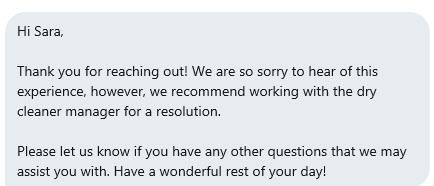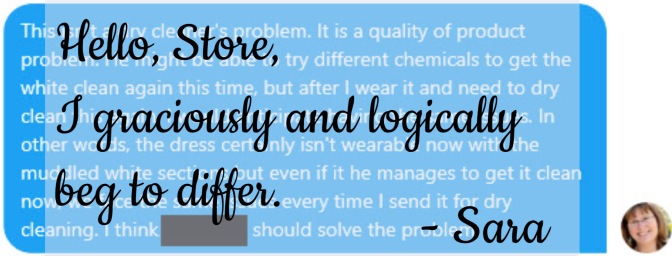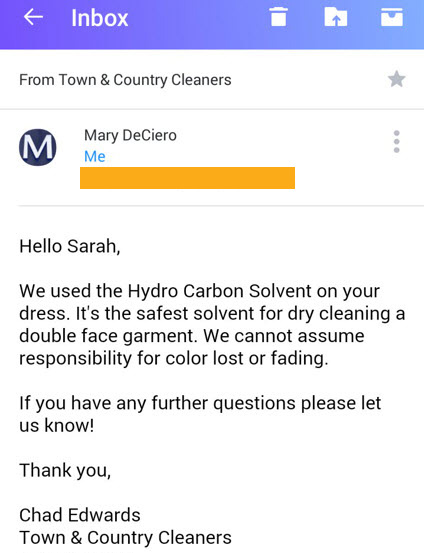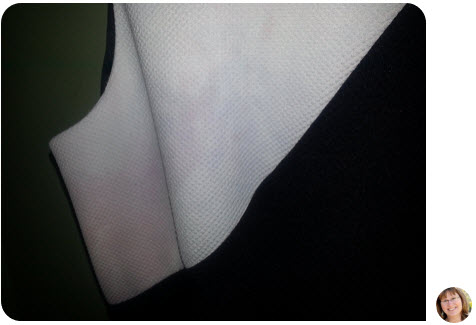The day I picked up my dry cleaning was much more pleasant than the cold, rainy day on which I’d dropped my two dresses onto the counter at Town & Country Cleaners.
I handed the girl at the counter my claim slip, and she pressed the button that began the parade of clean clothes around the loop that passed right by her register. But my dresses didn’t appear.
Perplexed, she looked at my claim slip more closely, asked me when I’d dropped them off, then, finally, asked a more senior employee. That employee looked at the computer, gave a knowing look — and then promptly called the store manager.
This couldn’t be good.
The bad news first, please
I was picking up two of my favorite dresses, one an orange, lacy number I wore with a blue scarf, perfect for work on Fridays before football games. The other was a flouncy, asymmetric navy and cream-colored affair that always drew compliments.
They were, unfortunately, dry clean only outfits, and I stretched the intervals between professional dry cleaning by using Dryel in my dryer for DIY cleaning. In fact, this was the first time I’d taken the dresses for a professional cleaning.
The manager appeared so apologetic I immediately wanted to forgive him even though I didn’t know the offense.
“I’m afraid I have bad news,” he said. “We’ve ruined your dress.”
He showed me the blue and cream dress; the blue dye had run into the cream, giving it a dingy look at best and a hint of a fourth-grade art class’s tie-dye experiment at worst. Not the classy look I wanted.
“We used all the standard chemicals and temperatures,” he explained, “but sometimes this happens on these two-toned pieces. The darker color runs into the lighter one. In this case, it also dyed all the other clothes in the load.”
“Oh, no!” I said. I was envisioning not just a ruined dress but, potentially, the cost of replacing other people’s clothing too.
“Have you ever had the dress professionally cleaned before?” he asked.
I explained that I’d used Dryel at home without incident but never had had the dress cleaned professionally before.
The good news?
“Well, we have some options. I could clean this again and attempt to get the dye out of the white sections; since it came out of the other clothes in the load, there’s a good chance it would come out of this as well.”
“But then wouldn’t I risk this happening again the next time I needed dry cleaning?”
He not only admitted that it was quite likely to happen again but that he also wouldn’t accept the article, knowing the risk.
“It has happened with a couple of higher-end dress manufacturers,” he said. “Most of the time, the client simply takes the dress back to the shop, explains the problem, and is reimbursed for the cost of the dress.”
“Well, I don’t want a dress that I can’t clean,” I said. “I’ll try to take it back to the store.”
“Well, let me give you my card, just in case they give you a problem.”
He pulled out his business card, added his personal cell phone to it, telling me to contact him if he could help.
“I’m happy to send you an email detailing the specific chemicals and processes we used — all industry standard — if that helps you get the dress refunded.”
I felt confident it wouldn’t be a problem.
“How much do I owe you?” I asked, knowing my dress had caused the shop a lot of extra work.
“Nothing,” he said. He wouldn’t even allow me to pay the cleaning fee for the orange dress.
“That is what customer service looks like,” I thought, contented as I drove away with my ruined dress.
What’s in your Twitter message?
Later that day, I reached out to the store where I’d purchased the dress using direct messaging on Twitter, explaining how their dress had been ruined by the required professional dry cleaning. I offered photos of the dress, the order number, even an email from the dry cleaner if they needed it in order to refund my purchase.

The store replied enthusiastically — and then told me to work it out with the dry cleaner manager. “Thanks for reaching out! … [We’re not going to help you.] … Have a wonderful rest of your day!” See?

Surely, the personnel did not understand the situation. I tried to clarify. I reiterated that the quality of the product, not the dry cleaner, was the problem.

Based on the store’s next response, it was apparent I still hadn’t made my point. The store said that since the dress was fine before I took it into the dry cleaner, clearly the dry cleaner was the problem.

The dress label indicated the dress was “dry clean only.” A dry cleaner following industry standards should be able to clean such a garment without incident — wouldn’t you think? I reached out to the dry cleaners and did get an email stating the process he’d used. I included the email, an image of the dress, and an only somewhat snarky message.



I thought I’d made my point. Apparently not. The store replied with this:

Well, I suppose that was logical. Except that the dress label indicated I should dry clean it. And normal, standard dry cleaning processes had left the dress in its current, unwearable state.
At that point, I was done. A bit ticked, yes, but done. The dress hadn’t cost me a fortune. To me, it was the principle of customer service. I’m not saying “the customer is always right,” but this customer was right. And may just choose not to be a customer in the future.

All the pleasant “kum ba ya” feelings I’d had carrying a ruined dress from an apologetic dry cleaner had fled. In their place was disbelief that a store wouldn’t attempt to retain a customer for a mere $37.26. (Yes, that was the cost of the dress; I love a bargain. And clothes. And variety. So I have to love a bargain.)
So be it. It was time to move on. (Finally, right? This exchange of messages occurred over three days, by the way.)
A couple days later, I noticed that I’d gotten a Twitter notification of a new message. It was the store. This was how that message began:

Clearly, another staff member had taken on Twitter communications. Or my “I guess I won’t have the same testimony” was taken for a threat. (Obviously not, since I’ve blacked out the name of the store.)
And so I took the dress — still bagged and hanging on the dry cleaner’s hanger — back to the store. Along with a printed version of all of the above. Just to make this easy for the clerk.
Did I get a “We’re so sorry for your trouble, we’ve credited your account”? Not so much. I got a dirty look from a clerk who took the pile of papers and went to converse with another employee, disappeared from sight, and then, quite reluctantly, credited my account.
That should not be what customer service looks like.
Despite getting what I requested, I never wanted to shop in that store again.
Isn’t it ironic that receiving a ruined, unwearable dress with great customer service made me much happier than receiving the desired refund with terrible customer service?
Great customer service doesn’t mean the customer always get what she wants. The owner of the dry cleaning business explained the problem, apologized without claiming fault, and offered to resolve the problem to the best of his ability (clean the stain out of my dress, give me his personal contact information, write an email to explain his processes to the store, etc.)
He refused to let me pay for any of my dry cleaning that day, though my dress had created a lot of extra work for him.
Though I left his business with a dress I would never wear again, I felt blessed.
Though the department store returned the money I’d paid for the dress, I left there feeling angry enough to never shop there again.
Great customer service made the difference between a happy customer and a former customer.
Photo by Nathan Dumlao on Unsplash


Amen 🙏🏽 I hate to haggle over something, when I know I’m right 😭
LikeLiked by 1 person
Thanks! I was a trifle indignant, I’ll admit.
LikeLiked by 1 person
😁😁
LikeLiked by 1 person